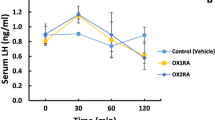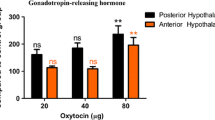Abstract
Obviously, opiates (e.g., morphine) are associated with the suppression and dysfunction of reproductive axis. It has been reported that substance P (SP) and RF-amid-related peptide-3 (RFRP-3) can exhibit anti-opioid effects in some regions of the nervous system. Moreover, SP and RFRP-3 are deemed as neuropeptides which exert modulatory and regulatory impacts on the function of the reproductive axis. The precise interactions of morphine with SP or RFRP-3 on the parameters of the reproductive activity, however, are not fully known. The present study was aimed to determine the impacts of the interaction of morphine either with SP or RFRP-3 on the hormonal and behavioral parameters of reproductive activity in male rats. In addition, it was aimed at determining whether the effects of these interactions rely on kisspeptin/G protein coupled receptor 54 (GPR54) pathway as the main upstream pulse generator and the mediator of the function of many inputs of gonadotropin-releasing hormone (GnRH)/luteinizing hormone (LH) system or not. Altogether, the resulted data from the sexual behavior tests, radioimmunoassay of LH/testosterone, and real-time quantitative PCR for the assessment of the expression of hypothalamic Kiss1, Gpr54, and Gnrh1 genes following concomitant administration of morphine with SP or RFRP-3 revealed that the suppressing effects of morphine on the parameters of reproductive axis activity can be affected by the administration of either RFRP-3 or SP. It is advocated that SP and RFRP-3, by the modulation of the expression of hypothalamic Kiss1, can possibly antagonize the effects of morphine on GnRH/LH system and sexual behavior.




Similar content being viewed by others
References
Agmo A, Paredes R, Fernandez H (1987) Differential effects of GABA transaminase inhibitors on sexual behavior, locomotor activity, and motor execution in the male rat. Pharmacol Biochem Behav 28:47–52
Ancel C, Bentsen AH, Sébert M-E, Tena-Sempere M, Mikkelsen JD, Simonneaux V (2012) Stimulatory effect of RFRP-3 on the gonadotrophic axis in the male Syrian hamster: the exception proves the rule. Endocrinology 153:1352–1363
Anjum S, Krishna A, Tsutsui K (2014) Inhibitory roles of the mammalian GnIH ortholog RFRP3 in testicular activities in adult mice. J Endocrinol 223:79–91
Arisawa M, De Palatis L, Ho R, Snyder GD, Wen HY, Pan G, McCann SM (1990) Stimulatory role of substance P on gonadotropin release in ovariectomized rats. Neuroendocrinology 51:523–529
Ayachi S, Simonin F (2014) Involvement of mammalian RF-amide peptides and their receptors in the modulation of nociception in rodents. Front Endocrinol 5:158
Bentley GE, Tsutsui K, Kriegsfeld LJ (2010) Recent studies of gonadotropin-inhibitory hormone (GnIH) in the mammalian hypothalamus, pituitary and gonads. Brain Res 1364:62–71
Ceccarelli I, De Padova A, Fiorenzani P, Massafra C, Aloisi A (2006) Single opioid administration modifies gonadal steroids in both the CNS and plasma of male rats. Neuroscience 140:929–937
Chen JC, Tsai H-W, Yeh K-Y, Tai M-Y, Tsai Y-F (2007) Male sexual behavior and catecholamine levels in the medial preoptic area and arcuate nucleus in middle-aged rats. Brain Res 1184:186–192
de Croft S, Boehm U, Herbison AE (2013) Neurokinin B activates arcuate kisspeptin neurons through multiple tachykinin receptors in the male mouse. Endocrinology 154:2750–2760
Cuello AC, Kanazawa I (1978) The distribution of substance P immunoreactive fibers in the rat central nervous system. J Comp Neurol 178:129–156
Culman J, Klee S, Ohlendorf C, Unger T (1997) Effect of tachykinin receptor inhibition in the brain on cardiovascular and behavioral responses to stress. J Pharmacol Exp Ther 280:238–246
Datar P, Srivastava S, Coutinho E, Govil G (2004) Substance P: structure, function, and therapeutics. Curr Top Med Chem 4:75–103
De Felipe C et al (1998) Altered nociception, analgesia and aggression in mice lacking the receptor for substance P. Nature 392:394–397
Dornan WA, Malsbury CW (1989) Peptidergic control of male rat sexual behavior: the effects of intracerebral injections of substance P and cholecystokinin. Physiol Behav 46:547–556
Ducret E, Anderson GM, Herbison AE (2009) RFamide-related peptide-3, a mammalian gonadotropin-inhibitory hormone ortholog, regulates gonadotropin-releasing hormone neuron firing in the mouse. Endocrinology 150:2799–2804
Dudás B, Merchenthaler I (2002) Close juxtapositions between LHRH immunoreactive neurons and substance P immunoreactive axons in the human diencephalon. J Clin Endocrinol Metab 87:2946–2953
Fergani C, Navarro VM (2017) Expanding the role of tachykinins in the neuroendocrine control of reproduction. Reproduction 153:R1–R14
Fergani C, Mazzella L, Coolen LM, McCosh RB, Hardy SL, Newcomb N, Grachev P, Lehman MN, Goodman RL (2016) Do substance P and neurokinin A play important roles in the control of LH secretion in ewes? Endocrinology 157:4829–4841
Findeisen M, Rathmann D, Beck-Sickinger AG (2011) RFamide peptides: structure, function, mechanisms and pharmaceutical potential. Pharmaceuticals 4:1248–1280
Gibson EM, Humber SA, Jain S, Williams WP III, Zhao S, Bentley GE, Tsutsui K, Kriegsfeld LJ (2008) Alterations in RFamide-related peptide expression are coordinated with the preovulatory luteinizing hormone surge. Endocrinology 149:4958–4969. https://doi.org/10.1210/en.2008-0316
Hasenöhrl RU, Jentjens O, Silva MADS, Tomaz C, Huston JP (1998) Anxiolytic-like action of neurokinin substance P administered systemically or into the nucleus basalis magnocellularis region. Eur J Pharmacol 354:123–133
Hendrikse M (2014) Interactions of GPR54 and GPR147 receptors with RF-amide ligands. University of Cape Town
Hinuma S, Shintani Y, Fukusumi S, Iijima N, Matsumoto Y, Hosoya M, Fujii R, Watanabe T, Kikuchi K, Terao Y, Yano T, Yamamoto T, Kawamata Y, Habata Y, Asada M, Kitada C, Kurokawa T, Onda H, Nishimura O, Tanaka M, Ibata Y, Fujino M (2000) New neuropeptides containing carboxy-terminal RFamide and their receptor in mammals. Nat Cell Biol 2:703–708
Jessop D, Chowdrey HS, Larsen PJ, Lightman SL (1992) Substance P: multifunctional peptide in the hypothalamo-pituitary system? J Endocrinol 132:331–337
Johnson MA, Tsutsui K, Fraley GS (2007) Rat RFamide-related peptide-3 stimulates GH secretion, inhibits LH secretion, and has variable effects on sex behavior in the adult male rat. Horm Behav 51:171–180
Kadokawa H, Shibata M, Tanaka Y, Kojima T, Matsumoto K, Oshima K, Yamamoto N (2009) Bovine C-terminal octapeptide of RFamide-related peptide-3 suppresses luteinizing hormone (LH) secretion from the pituitary as well as pulsatile LH secretion in bovines. Domest Anim Endocrinol 36:219–224
Kaewwongse M, Takayanagi Y, Onaka T (2011) Effects of RFamide-related peptide (RFRP)-1 and RFRP-3 on oxytocin release and anxiety-related behaviour in rats. J Neuroendocrinol 23:20–27. https://doi.org/10.1111/j.1365-2826.2010.02077.x
Kalra PS, Sahu A, Bonavera JJ, Kalra SP (1992) Diverse effects of tachykinins on luteinizing hormone release in male rats: mechanism of action. Endocrinology 131:1195–1201
Kaur G, Kaur G (2001) Role of cholinergic and GABAergic neurotransmission in the opioids-mediated GnRH release mechanism of EBP-primed OVX rats. Mol Cell Biochem 219:13–19
Kawaguchi Y, Hoshimaru M, Nawa H, Nakanishi S (1986) Sequence analysis of cloned cDNA for rat substance P precursor: existence of a third substance P precursor. Biochem Biophys Res Commun 139:1040–1046
Khazali H, Mahmoudi F, Janahmadi M (2018) Hypothalamic KiSS1/GPR54 gene expressions and luteinizing hormone plasma secretion in morphine treated male rats. Int J Fertil Steril 12
Kriegsfeld LJ, Mei DF, Bentley GE, Ubuka T, Mason AO, Inoue K, Ukena K, Tsutsui K, Silver R (2006) Identification and characterization of a gonadotropin-inhibitory system in the brains of mammals. Proc Natl Acad Sci 103:2410–2415
Lehman MN, Hileman SM, Goodman RL (2013) Neuroanatomy of the kisspeptin signaling system in mammals: comparative and developmental aspects. In: Kisspeptin signaling in reproductive biology. Springer, pp 27–62
Li S, Pelletier G (1993) Opioid regulation of gonadotropin-releasing hormone gene expression in the male rat brain as studied by in situ hybridization. Neuroreport 4:331–333
Livak KJ, Schmittgen TD (2001) Analysis of relative gene expression data using real-time quantitative PCR and the 2(−Delta Delta C(T)) method. Methods (San Diego, Calif) 25:402–408. https://doi.org/10.1006/meth.2001.1262
Mikkelsen JD, Simonneaux V (2009) The neuroanatomy of the kisspeptin system in the mammalian brain. Peptides 30:26–33
Min L, Leon S, Li H, Pinilla L, Carroll RS, Tena-Sempere M, Kaiser UB (2015) RF9 acts as a KISS1R agonist in vivo and in vitro. Endocrinology 156:4639–4648
Navarro VM et al (2014) The integrated hypothalamic tachykinin-kisspeptin system as a central coordinator for reproduction. Endocrinology 156:627–637
Pfaus JG, Gorzalka BB (1987) Opioids and sexual behavior. Neurosci Biobehav Rev 11:1–34
Pineda R, Garcia-Galiano D, Sanchez-Garrido MA, Romero M, Ruiz-Pino F, Aguilar E, Dijcks FA, Blomenröhr M, Pinilla L, van Noort PI, Tena-Sempere M (2010a) Characterization of the potent gonadotropin-releasing activity of RF9, a selective antagonist of RF-amide-related peptides and neuropeptide FF receptors: physiological and pharmacological implications. Endocrinology 151:1902–1913
Pineda R et al. (2010b) Characterization of inhibitory roles of RFRP3, the mammalian ortholog of GnIH, in the control of gonadotropin secretion in the rat: in vivo and in vitro studies. American Journal of Physiology-Heart and Circulatory Physiology
Relf H-L, Rizwan MZ, Anderson GM, Evans JJ (2009) Central and peripheral effects of RFamide-related peptide-3 on luteinizing hormone and prolactin secretion in rats. Endocrinology 150:1834–1840. https://doi.org/10.1210/en.2008-1359
Rizwan MZ, Poling MC, Corr M, Cornes PA, Augustine RA, Quennell JH, Kauffman AS, Anderson GM (2012) RFamide-related peptide-3 receptor gene expression in GnRH and kisspeptin neurons and GnRH-dependent mechanism of action. Endocrinology 153:3770–3779
Ruiz-Pino F et al (2014) Effects and interactions of tachykinins and dynorphin on FSH and LH secretion in developing and adult rats. Endocrinology 156:576–588
Sahin Z, Canpolat S, Ozcan M, Ozgocer T, Kelestimur H (2015) Kisspeptin antagonist prevents RF9-induced reproductive changes in female rats. Reproduction 149:465–473
Sawynok J, Moochhala S, Pillay D (1984) Substance P, injected intrathecally, antagonizes the spinal antinociceptive effect of morphine, baclofen and noradrenaline. Neuropharmacology 23:741–747
Schlesinger K, Pelleymounter MA, van de Kamp J, Bader DL, Stewart JM, Chase TN (1986) Substance P facilitation of memory: effects in an appetitively motivated learning task. Behav Neural Biol 45:230–239
Shacoori V, Guerin J, Girre A, Saïag B, Rault B (1992) Effect of naloxone and β-casomorphin on the hypothalamic-pituitary-luteinizing hormone axis in vitro. Life Sci 51:899–907
Simavli S, Thompson IR, Maguire CA, Gill JC, Carroll RS, Wolfe A, Kaiser UB, Navarro VM (2015) Substance p regulates puberty onset and fertility in the female mouse. Endocrinology 156:2313–2322
Son YL, Ubuka T, Soga T, Yamamoto K, Bentley GE, Tsutsui K (2016) Inhibitory action of gonadotropin-inhibitory hormone on the signaling pathways induced by kisspeptin and vasoactive intestinal polypeptide in GnRH neuronal cell line, GT1-7. FASEB J 30:2198–2210
Swann JM, Newman SW (1992) Testosterone regulates substance P within neurons of the medial nucleus of the amygdala, the bed nucleus of the stria terminalis and the medial preoptic area of the male golden hamster. Brain Res 590:18–28
Tsutsui K, Bentley GE, Bedecarrats G, Osugi T, Ubuka T, Kriegsfeld LJ (2010) Gonadotropin-inhibitory hormone (GnIH) and its control of central and peripheral reproductive function. Front Neuroendocrinol 31:284–295
Ubuka T, Son YL, Tobari Y, Tsutsui K (2012) Gonadotropin-inhibitory hormone action in the brain and pituitary. Front Endocrinol 3:148
Ullah R, Shen Y, Y-d Z, Huang K, J-f F, Wahab F, Shahab M (2016) Expression and actions of GnIH and its orthologs in vertebrates: current status and advanced knowledge. Neuropeptides 59:9–20
Vignozzi L, Corona G, Petrone L, Filippi S, Morelli A, Forti G, Maggi M (2005) Testosterone and sexual activity. J Endocrinol Investig 28:39–44
Vuong C, Van Uum SH, O'dell LE, Lutfy K, Friedman TC (2009) The effects of opioids and opioid analogs on animal and human endocrine systems. Endocr Rev 31:98–132
Watson C (2014) Paxinos and Watson’s the rat brain in Stereotaxic Coordinates
Xiang W et al (2015) The inhibitory effects of RFamide-related peptide 3 on luteinizing hormone release involves an estradiol-dependent manner in prepubertal but not in adult female mice. Biol Reprod 93(30):31–39
Funding
This study was financially and technically supported by Shahid Beheshti University, Tehran, Iran.
Author information
Authors and Affiliations
Corresponding author
Ethics declarations
Ethical Approval
All experiments were carried out in the Laboratory of Animal Center and were in accordance with the recommendation of Animal Research Ethic Committee of Shahid Beheshti University, Tehran, Iran.
Competing Interests
The authors declare that they have no competing interests.
Additional information
Publisher’s Note
Springer Nature remains neutral with regard to jurisdictional claims in published maps and institutional affiliations.
Rights and permissions
About this article
Cite this article
Rahdar, P., Khazali, H., Hosseini, A. et al. The Impact of Morphine on Reproductive Activity in Male Rats Is Regulated by Rf-Amid-Related Peptide-3 and Substance P Adjusting Hypothalamic Kisspeptin Expression. J Mol Neurosci 69, 456–469 (2019). https://doi.org/10.1007/s12031-019-01375-z
Received:
Accepted:
Published:
Issue Date:
DOI: https://doi.org/10.1007/s12031-019-01375-z




